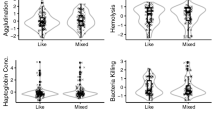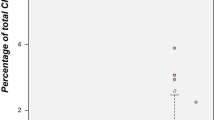Abstract
IN nature the rabbit flea, Spilopsyllus cuniculi (Dale), copulates and lays fertile eggs only on the newborn young (1–9 days old), although the female undergoes maturation on the pregnant doe as well as on the nestlings1,2. It was found that human growth hormone injected into the host can stimulate copulation of the matured rabbit flea feeding on nestlings 10–15 days old3, but it was also realized that several other factors must be involved in controlling pairing and impregnation on the newborn young, apart from the hormones ingested with the blood of the host. We decided independently that rabbit fleas probably matured faster when feeding on nestlings in large litters than on nestlings in small litters. This could have been due to different hormone levels in the blood of large healthy litters, for hormone concentrations apparently vary considerably from litter to litter and individual to individual. Thus fleas regularly mature faster and more effectively on certain pregnant doe rabbits than on others, and, furthermore, the concentrations of corticosterone in the host's blood seem to vary with the season4. Other variable factors such as humidity and temperature in large nests could have been responsible for the difference observed, but it also seemed that an environmental or pheromone-like “nestling factor” might be involved. The following preliminary experiments were carried out to investigate this situation.
This is a preview of subscription content, access via your institution
Access options
Subscribe to this journal
Receive 51 print issues and online access
$199.00 per year
only $3.90 per issue
Buy this article
- Purchase on Springer Link
- Instant access to full article PDF
Prices may be subject to local taxes which are calculated during checkout
Similar content being viewed by others
References
Mead-Briggs, A. R., J. Exp. Biol., 41, 371 (1964).
Rothschild, M., and Ford, B., Nature, 201, 103 (1964).
Rothschild, M., and Ford, B., Nature, 211, 261 (1966).
Exley, D., Ford, B., and Rothschild, M., Proc. Roy. Entomol. Soc., (C) 30, 35 (1965).
Rothschild, M., Endeavour, XXIV (93), 162 (1965).
Author information
Authors and Affiliations
Rights and permissions
About this article
Cite this article
ROTHSCHILD, M., FORD, B. Does a Pheromone-like Factor from the Nestling Rabbit stimulate Impregnation and Maturation in the Rabbit Flea?. Nature 221, 1169–1170 (1969). https://doi.org/10.1038/2211169a0
Received:
Issue Date:
DOI: https://doi.org/10.1038/2211169a0
This article is cited by
-
Host dependency among haematophagous insects: A case study on flea-host association
Proceedings: Animal Sciences (1987)
-
Studies on host-flea relationship
Zeitschrift f�r Parasitenkunde (1976)
Comments
By submitting a comment you agree to abide by our Terms and Community Guidelines. If you find something abusive or that does not comply with our terms or guidelines please flag it as inappropriate.



